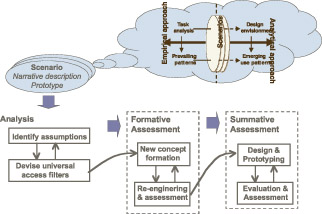
|
|
ERCIM News No.46, July 2001 [contents]
|
by Constantine Stephanidis and Demosthenes Akoumianakis
IS4ALL ó Information Society for All ó is a European project that provides a methodological frame of reference which introduces universal access principles into the design of Health Telematics applications and services. The characteristics of Health Telematics, such as the variety of end users involved, the changing Healthcare contexts of use and the penetration of new computer-mediated activities, make it a rich field of inquiry and re-shape the way in which healthcare practices are structured and organized.
IS4ALL (IST-1999-14101) seeks to establish a wide, interdisciplinary and closely collaborating ënetwork of expertsí (Working Group) to provide the European Health Telematics industry with a comprehensive information package detailing how to appropriate the benefits of Universal Design. While the specific technological / scientific objectives to be attained by IS4ALL have been described in ERCIM News 43, this article will elaborate on recent technical developments concerning the advancement of methodological support for introducing universal access principles into the design of Health Telematics applications and services. The project departs from the traditional perspectives of universal access as a set of high-level principles or guidelines, which can be interpreted to provide the required design insights, and instead, it emphasizes an analytical and process-oriented approach, which blends scenario-based perspectives on systems development and structured argumentation to re-shape and filter scenarios.
Scenarios are perceived as narrative descriptions of computer-mediated human activities in a Health Telematics environment. The social setting of a Health Telematics environment may be bound to a clinic within the hospital, a ward within a clinic or even to the end users business or residential environment. The scope of such scenarios is intended to be narrow and focused on a very specific issue. As an example, a possible scenario would be focused on patientís access to the electronic healthcare record from home, or while on the move, using a portable device, which runs on a particular platform.
Generating the Scenario
Scenarios can be developed at different levels. They can range from vision-oriented statements of intended actions to concrete experiences with an implemented artefact. Since scenarios may or may not have an explicit focus on universal access, a key question is to devise suitable mechanism or techniques for working with these scenarios to derive useful insights for the purposes of the project (see figure).
 |
| Working with scenarios — steps and phases in IS4ALL. |
Working with the Scenario
Working with the scenario entails a process of structured argumentation, which results in unfolding, recording and reflecting upon implicit/explicit claims embodied in the original scenario. Since we are concerned with designing for diversity, an appropriate argumentation framework should accommodate arguments in support or against universal access. To this effect, rather than starting from high-level principles and guidelines, we are in favour of a more direct and structured approach leading to a structured argumentation technique based on the notion of accessibility filters. Accessibility filters may take several forms. The most popular is that of questions, which seek to provide insights into how a particular product is to be used (by specific user groups, novel contexts of use, or different platforms).
Scenario Screening: Setting Accessibility Filters and Relaxing some of the Implicit Assumptions
Accessibility filters are specific issues depicting emerging patterns of use necessitated either by an intention to accommodate diversity in the design of the task or by the need to re-engineer an artefact. For instance plausible accessibility filters could be the following:
Each one of these filters may be used to re-engineer the original scenario (or the artefacts implied) so as to provide instances, which satisfy the filter.
Identifying Breakdowns and Envisioning New Design Alternatives
This involves a conscious effort to encounter potential problems, envision solutions and unfold alternatives. Thus for instance, developing further the first accessibility filter may lead to changes in the interaction with the artefact or perhaps to the introduction of new artefacts, such as visual keyboards for text entries or alternative window management facilities.
What is important to note about accessibility filters is that they play a dual role in design. Firstly, they are useful when there is a tentative design to be assessed. In such cases, they help designers identify potential break down or shortcomings in the use of the product. Moreover, they can also be used as a basis for argumentation during design, thus fostering an analytical insight to accessible design. Nevertheless, accessibility filters do not provide answers. Rather, they motivate designers to think about certain aspects of a problem.
Acknowledgements
IS4ALL comprises one co-ordinating partner, namely ICS-FORTH, and several member organisations, including Microsoft Healthcare Users Group Europe (MS-HUGe), European Health Telematics Association (EHTEL), CNR-IROE, GMD, INRIA and Fraunhofer-Gesellschaft zur Foerderung der angewandten Forschung e.V.óInstitut fur Arbeitswirtschaft und Organisation (FhG-IAO).
Please contact:
Constantine Stephanidis ó ICS-FORTH
Tel: +30 81 391741
E-mail: cs@ics.forth.gr